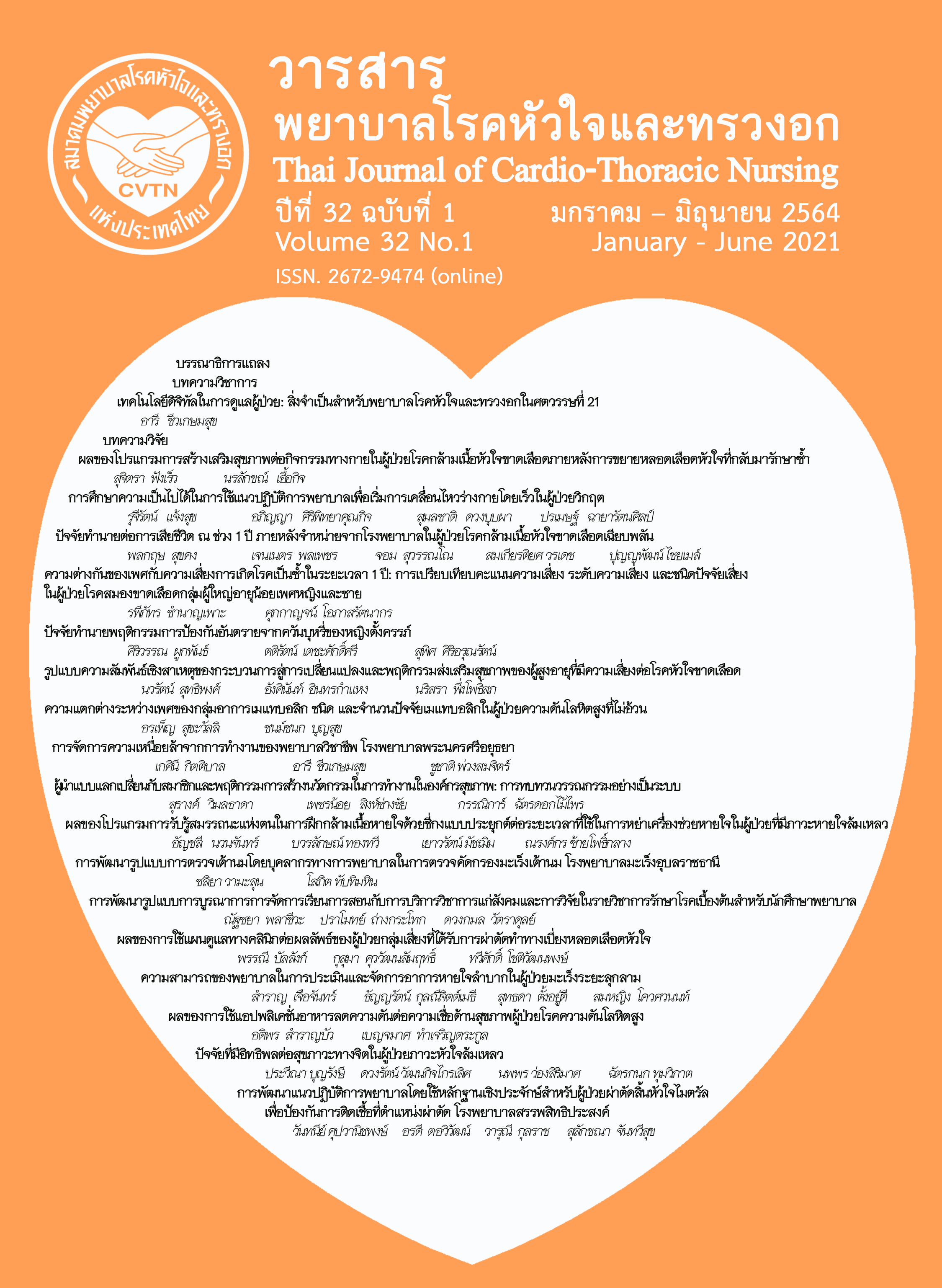ปัจจัยทำนายพฤติกรรมการป้องกันอันตรายจากควันบุหรี่ของหญิงตั้งครรภ์
คำสำคัญ:
พฤติกรรมการป้องกัน, บุหรี่, หญิงตั้งครรภ์บทคัดย่อ
การศึกษานี้เป็นการวิจัยเชิงทำนาย เพื่อศึกษาปัจจัยทำนายพฤติกรรมการป้องกันอันตรายจากควันบุหรี่ของหญิงตั้งครรภ์ กลุ่มตัวอย่าง คือ หญิงตั้งครรภ์ที่มารับบริการฝากครรภ์ โรงพยาบาลพระนารายณ์มหาราช จังหวัดลพบุรี จำนวน 130 ราย เครื่องมือการวิจัยประกอบด้วยแบบสอบถามข้อมูลส่วนบุคคล แบบสอบถามการรับรู้ประโยชน์ในการป้องกันอันตรายจากควันบุหรี่ แบบสอบถามการรับรู้อุปสรรคในการป้องกันอันตรายจากควันบุหรี่ แบบสอบถามการรับรู้ความสามารถของตนเองในการป้องกันอันตรายจากควันบุหรี่ แบบสอบถามการสนับสนุนทางสังคมในการป้องกันอันตรายจากควันบุหรี่ และแบบสอบถามพฤติกรรมการป้องกันอันตรายจากควันบุหรี่ของหญิงตั้งครรภ์ วิเคราะห์ข้อมูลด้วยสถิติพรรณนาและการวิเคราะห์การถดถอยพหุคูณแบบขั้นตอน
ผลการศึกษาพบว่า กลุ่มตัวอย่างมีพฤติกรรมการป้องกันอันตรายจากควันบุหรี่เฉลี่ยเท่ากับ 31.53 (SD = 4.68) ปัจจัยที่สามารถทำนายพฤติกรรมการป้องกันอันตรายจากควันบุหรี่ของหญิงตั้งครรภ์ ได้แก่ การสนับสนุนทางสังคมในการป้องกันอันตรายจากควันบุหรี่ (β = .63, p < .001) และการรับรู้อุปสรรคในการป้องกันอันตรายจากควันบุหรี่ (β = -.16, p = .026) สามารถร่วมกันทำนายพฤติกรรมการป้องกันอันตรายจากควันบุหรี่ของหญิงตั้งครรภ์ ได้ร้อยละ 50.9 (F(2, 127) = 65.72, p < .001)
ผลการวิจัยนี้สามารถนำไปใช้ในการพัฒนาโปรแกรมส่งเสริมการมีส่วนร่วมของสามีหรือสมาชิกในครอบครัวเพื่อป้องกันอันตรายจากควันบุหรี่ในหญิงตั้งครรภ์
เอกสารอ้างอิง
World Health Organization. WHO recommendations for the prevention and management of tobacco use and second-hand smoke exposure in pregnancy. [document on the Internet]. 2013. Available from: https://apps.who.int/iris/bitstream/handle/10665/94555/9789241506076eng.pdf;jsessionid=D13EBDC7DA7C2078F1527FA7C6E9C8CB?sequence=1.
Zhang L, Hsia J, Tu X, Xia Y, Zhang L, Bi Z, et al. Exposure to secondhand tobacco smoke and Intervention among pregnant women in China: a systematic review. Prev Chronic Dis. 2015; 12: E35.
Tong VT, Morello P, Alemán A, Johnson C, Dietz PM, Farr SL, et al. Pregnant women's secondhand smoke exposure and receipt of screening and brief advice by prenatal care providers in Argentina and Uruguay. Matern Child Health J. 2015; 19(6): 1376-83.
Srituee S, Sriwong N, Kangwantrakul W, Trakulthong J, Promdee L. Prevalence of second-hand smoking and urinary cotinine in pregnant women. J Med Tech Assoc Thailand. 2012;40(3): 4339-47. (in Thai).
Ouiyanukoon P, Kalayasiri R. Prevalence and related factors of pregnant women received second hand smoke during pregnancy. Chula Med J. 2016; 60(6): 689-98. (in Thai).
Mbah AK, Salihu HM, Dagne G, Wilson RE, Bruder K. Exposure to environmental tobacco smoke and risk of antenatal depression. Arch Womens Ment Health. 2013; 16(4):293-302.
Leonardi-Bee J, Britton J, Venn A. Secondhand smoke and adverse fetal outcomes in nonsmoking pregnant women: a meta-analysis. Pediatrics. 2011; 127(4): 734-41.
Vivilaki VG, Diamanti A, Tzeli M, Patelarou E, Bick D, Papadakis S, et al. Exposure to active and passive smoking among Greek pregnant women. Tob. Induc. Dis. 2016; 14:12.
Kharrazi M, DeLorenze GN, Kaufman FL, Eskenazi B, Bernert JT Jr, Graham S, Pearl M, Pirkle J. Environmental tobacco smoke and pregnancy outcome. Epidemiology. 2004; 15(6): 660-70.doi: 10.1097/01.ede.0000142137.39619. 60. PMID: 15475714.
Thai Health Promotion Foundation. How to behave? Keep far away from cigarette smoke. [document on the Internet]. 2013. Available from: https://www.thaihealth.or.th/ Content /16457.
Pender NJ, Murdaugh CL, Parsons MA. Health promotion in nursing practice. 7th edition. Boston, MA: Pearson education; 2015.
Thongkanya R, Preechawong S. Factors predicting second-hand smoke avoidance behavior in chronic illness patients, Bangkok metropolis. Journal of The Royal Thai Army Nurses. 2014; 15(2): 331-8. (in Thai).
Prathumsuwan A, Kalampakorn S, Inthasorn P. Secondhand smoke avoidance behavior in women with smoking family member. Thai Journal of Nursing. 2019; 68(2): 17-26. (in Thai).
Mazloomy Mahmoodabad SS, Karimiankakolaki Z, Kazemi A, Fallahzadeh H. Self‑efficacy and perceived barriers of pregnant women regarding exposure to second‑hand smoke at home. J Educ and Health Promot. 2019; 8: 139.
Lee JY, Ahn H, Lee H. Factors affecting secondhand smoke avoidance behavior of Vietnamese adolescents. Int J Environ Res Public Health. 2018; 15(8): 1632.
Tabachnick BG, Fidell LS. Using Multivariate Statistics. (6th ed.). Boston, MA: Pearson education; 2013.
Srisatidnarakul B. Development and validation of research instruments: psychometric properties. Bangkok: Chulalongkorn University Printing House; 2012.
Xu X, Rao Y, Abdullah AS, Sharma M, Guo JJ, Zhao Y. Preventive behaviours in avoiding indoor secondhand smoke exposure among pregnant women in China. Tob Control. 2017; 26(4): 483-4.
Suebsuk P, Pongnumkul A, Sareewiwatthana P. Predicting factors of health promoting behaviors to preventive environmental lung diseases among motorcycle taxi drivers in Bangkok metropolitan area. Journal of Nursing Science. 2013; 31(1): 48-58. (in Thai).
Phetphoom C, Pyeamkleep R, Pongpreecha B. Factors affecting avoidance behavior of secondhand smoke among students in the University. The Public Health Journal of Burapha University. 2018; 13(2): 89-101. (in Thai).
ดาวน์โหลด
เผยแพร่แล้ว
รูปแบบการอ้างอิง
ฉบับ
ประเภทบทความ
สัญญาอนุญาต
บทความนี้ยังไม่เคยตีพิมพ์หรืออยู่ในระหว่างส่งไปตีพิมพ์ในวารสารอื่น ๆ มาก่อน และกองบรรณาธิการขอสงวนสิทธิ์ในการตรวจทาน และแก้ไขต้นฉบับตามเกณฑ์ของวารสาร ในกรณีที่เรื่องของท่านได้ได้รับการตีพิมพ์ในวารสารฉบับนี้ถือว่าเป็น ลิขสิทธิ์ของวารสารพยาบาลโรคหัวใจและทรวงอก






